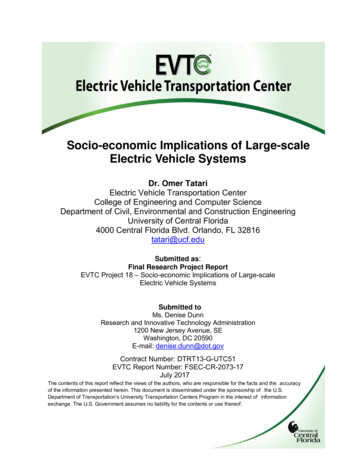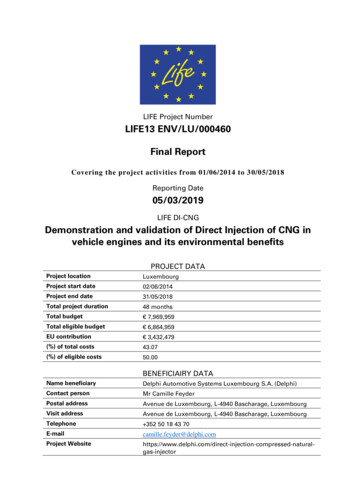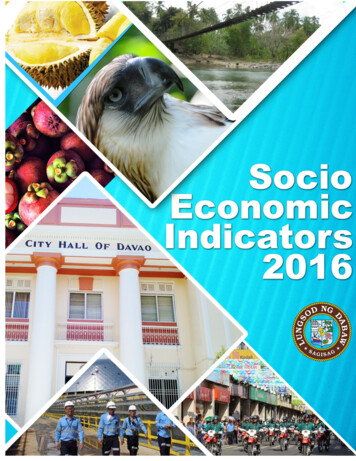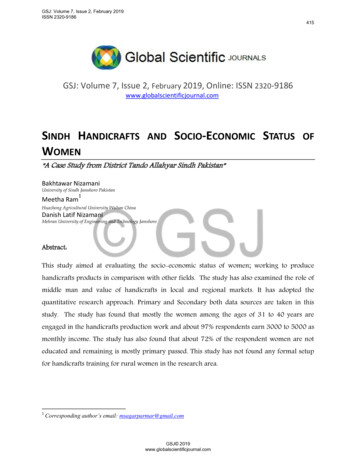
Transcription
Cambridge University Press978-1-107-04595-8 - Socio-Economic Development: Second EditionAdam SzirmaiFrontmatterMore informationSocio-Economic DevelopmentWhy are poor countries poor and rich countries rich? How are wealth and poverty related tochanges in health, life expectancy, education, population growth and politics? This nontechnical introduction to development studies explores the dynamics of socio-economicdevelopment and stagnation in developing countries. Thoroughly updated and revised, thissecond edition includes new material on the effects of the 2008 financial crisis, theemergence of the BRICS economies, the role of institutions in development and theaccelerated growth of economies in Africa and Asia. Taking a comparative approach,Szirmai places contemporary debates within their broader contexts and combines insightsand theories from economics, economic history, political science, anthropology and sociology. Each chapter includes comparative statistics and time series for thirty-one developingcountries. Assuming no prior knowledge of economics, this book is well suited for studentsin interdisciplinary development studies and development economics, for policy makers andfor practitioners pursuing careers in developing countries.Adam Szirmai is Professorial Fellow at the United Nations University Maastricht Economicand Social Research Institute on Innovation and Technology (UNU-MERIT) and Professorof Development Economics at Maastricht University. His research focuses on the determinants of long-run growth, catch-up and stagnation in the developing world, with particularemphasis on the role of the manufacturing sector. A second focus of his research concernsthe relationships between innovation, technological change and economic growth. in this web service Cambridge University Presswww.cambridge.org
Cambridge University Press978-1-107-04595-8 - Socio-Economic Development: Second EditionAdam SzirmaiFrontmatterMore information in this web service Cambridge University Presswww.cambridge.org
Cambridge University Press978-1-107-04595-8 - Socio-Economic Development: Second EditionAdam SzirmaiFrontmatterMore informationSocio-EconomicDevelopmentSecond editionADAM SZIRMAIMaastricht University/UNU-MERIT in this web service Cambridge University Presswww.cambridge.org
Cambridge University Press978-1-107-04595-8 - Socio-Economic Development: Second EditionAdam SzirmaiFrontmatterMore informationUniversity Printing House, Cambridge CB2 8BS, United KingdomCambridge University Press is part of the University of Cambridge.It furthers the University’s mission by disseminating knowledge in the pursuit ofeducation, learning and research at the highest international levels of excellence.www.cambridge.orgInformation on this title: www.cambridge.org/9781107624498 Adam Szirmai 2015This publication is in copyright. Subject to statutory exceptionand to the provisions of relevant collective licensing agreements,no reproduction of any part may take place without the writtenpermission of Cambridge University Press.First published 2005Second edition 2015Printed in the United Kingdom by TJ International Ltd. Padstow CornwallA catalogue record for this publication is available from the British LibraryISBN 978-1-107-04595-8 HardbackISBN 978-1-107-62449-8 PaperbackAdditional resources for this publication at www.cambridge.org/szirmai2.Cambridge University Press has no responsibility for the persistence or accuracy ofURLs for external or third-party internet websites referred to in this publication,and does not guarantee that any content on such websites is, or will remain,accurate or appropriate. in this web service Cambridge University Presswww.cambridge.org
Cambridge University Press978-1-107-04595-8 - Socio-Economic Development: Second EditionAdam SzirmaiFrontmatterMore informationCONTENTSList of tablesList of figuresList of boxesPrefaceAcknowledgementsList of acronyms and abbreviationsxvxviixviiixxixxvxxvi1 Developing countries and the concept of 0.1Approaches to developmentThe development debateGrowth and developmentAre growth and development desirable?Development and WesternisationIndicators of growth and developmentDoes the ‘Third World’ exist?The gap between rich and poor countriesWhat do developing countries have in common?The framework of proximate, intermediate and ultimate sources of growthand developmentQuestions for reviewFurther reading2 Development of the international economic order, 1450–20152.1.2.2.2.3.2.4.International economic orderEconomic breakthrough and external expansion from Western Europe2.2.1. Economic growth before 15002.2.2. Pre-modern international orders2.2.3. China in the fourteenth and fifteenth centuriesWhy expansion from Europe instead of from China?European expansion in the world2.4.1. Types of international economic orders2.4.2. The first wave of expansion, 1400–18152.4.3. The first wave of decolonisation2.4.4. The second phase of European expansion, 1815–19132.4.5. The period 1870–19132.4.6. Migration flows2.4.7. Non-colonised areas2.4.8. Latecomers in the process of economic development in this web service Cambridge University 8596565www.cambridge.org
Cambridge University Press978-1-107-04595-8 - Socio-Economic Development: Second EditionAdam SzirmaiFrontmatterMore informationviContents2.4.9. The period 1913–502.4.10. The period after the Second World War2.4.11. Two perspectives on developments in the world economy, 1450–20152.5. Key issues in developmentQuestions for reviewFurther reading3 Growth and stagnation: theories and experiences3.1.3.2.73What are the sources of growth and development?Classical thinking about growth, development and stagnation3.2.1. Adam Smith3.2.2. The classical economists Ricardo, Malthus and Mill3.2.3. Friedrich List3.2.4. Classical sociologists: Spencer, Tönnies and Durkheim3.2.5. Karl Marx3.2.6. Theories of imperialism3.2.7. Max Weber and Joseph Schumpeter3.3. Internal and external approaches3.4. Explanations of economic backwardness3.4.1. Rostow’s theory of the stages of economic growth3.4.2. Kuznets’ preconditions for industrialisation3.4.3. Neoclassical theories of growth3.4.4. Growth accounting3.4.5. New growth theory3.4.6. North and Thomas: efficient institutions3.4.7. Myrdal: institutional reforms3.4.8. Rodrik: identifying the binding constraints to growth3.5. Explanations of underdevelopment3.5.1. Neo-Marxist theories of underdevelopment3.5.2. Structuralism and theories of unequal exchange3.5.3. Underdevelopment theories: an evaluation3.6. Combining internal and external influences3.6.1. Advantages of technological backwardness3.6.2. Evolutionary theories of economic change3.7. Empirical study of development experiences3.7.1. Growth of income per capita: can developing countries escapestagnation?3.7.2. Investment: how important is capital?3.7.3. Export performance3.7.4. Can primary exporters become manufacturing exporters?3.7.5. External finance: does money flow from poor to rich countries?3.7.6. Are developing countries dominated by foreign interests?3.7.7. Are developing countries capable of structural change?3.7.8. How unequal is the income distribution?Questions for reviewFurther reading in this web service Cambridge University 5128129www.cambridge.org
Cambridge University Press978-1-107-04595-8 - Socio-Economic Development: Second EditionAdam SzirmaiFrontmatterMore informationviiContents4 Technology and development1314.1.4.2.4.3.The role of technologyThe technology raceTechnological change and increases in productive capacity4.3.1. How to increase labour productivity?4.3.2. Investing in technological change4.3.3. Diffusion of technology and absorptive capabilities4.3.4. The knowledge economy: technology, productivity and competitiveness4.4. Indicators for science, technology and innovation4.5. Economic theories about the role of technological change revisited4.6. Consequences of the acceleration of technological development fordeveloping countries4.6.1. Acceleration of global technological change4.6.2. Knowledge gaps4.6.3. New opportunities offered by technological development4.6.4. New threats4.7. International technology transfer and technology diffusion4.7.1. International technology transfer4.7.2. Intellectual property rights4.7.3. Absorptive capacity4.8. Biotechnology and information and communication technology4.8.1. Biotechnology4.8.2. Information and communication technology4.9. National and international policyQuestions for reviewFurther reading5 Population and ectives on population growthGrowth of world populationThe demographic transitionDemographic developments in developing countriesSocio-economic consequences of population growth5.6.1. Pessimistic and optimistic perspectives5.6.2. Malthusian analyses5.6.3. The Neo-Malthusian trap5.6.4. Growth of national income, growth of per capita income and thedependency ratio5.6.5. Changes in the age structure and the demographic dividend5.6.6. Dependency ratio and savings5.6.7. Population growth and investment5.6.8. Population growth, education and healthcare5.6.9. Employment, income distribution and poverty5.6.10. Population growth and the environment in this web service Cambridge University 172174174175176176177178178181www.cambridge.org
Cambridge University Press978-1-107-04595-8 - Socio-Economic Development: Second EditionAdam SzirmaiFrontmatterMore informationviiiContents5.6.11.Population growth and technological progress5.6.12.Consequences of population growth: concluding remarks5.7. Why do people in developing countries have so many children?5.7.1. Introduction5.7.2. Intermediate determinants of fertility: the Bongaarts model5.7.3. Economic explanations of fertility5.7.4. Cultural and institutional explanations of fertility5.8. PolicyQuestions for reviewFurther reading1871881881881891901921941971976 Health, healthcare and development6.1.199The state of health in developing countries6.1.1. Quantitative indicators of the state of health6.1.2. Infant and child mortality6.1.3. Life expectancy6.1.4. Patterns of disease and health6.1.5. Common infectious and parasitic diseases in developing countries6.1.6. Epidemiological transition6.2. Theoretical explanations of changes in health and morbidity6.2.1. Factors affecting the state of health6.2.2. Preston: per capita income and life expectancy6.2.3. McKeown: the importance of nutrition6.2.4. Preston and McKeown6.2.5. The Mosley model and the importance of education6.2.6. Caldwell: the importance of healthcare policy6.2.7. Standards of living, education, medical technology and healthcaresystems: a synthesis6.3. Health and economic development6.4. Healthcare policyQuestions for reviewFurther reading7 Education and development7.1.7.2.Theories of the contribution of education to economic development7.1.1. ‘Human capital’ theory7.1.2. Criticisms of human capital theory7.1.3. Screening theory7.1.4. Criticisms of screening theory7.1.5. An evaluation of the human capital debate7.1.6. Education as a necessary but not sufficient condition fordevelopment: thresholds and complementaritiesIndicators of educational development7.2.1. Indicators of educational enrolment7.2.2. Educational attainments in this web service Cambridge University ambridge.org
Cambridge University Press978-1-107-04595-8 - Socio-Economic Development: Second EditionAdam SzirmaiFrontmatterMore informationixContents7.2.3. Financial indicators7.2.4. Physical indicators7.2.5. Educational outcomes: literacy7.2.6. Educational outcomes: cognitive skills7.3. Educational performance in developing countries7.3.1. The initial situation after the Second World War7.3.2. Increases in educational enrolment7.3.3. Education completed7.3.4. Years of education per member of the population7.3.5. Educational expenditures7.3.6. Cognitive skills7.3.7. Non-formal and informal education7.3.8. Literacy7.3.9. Nation building7.3.10. Summary: comparison with developments in more developedcountries7.4. Problems and challenges7.4.1. Discrepancies between educational needs and financial resources7.4.2. The quality of education7.4.3. Lack of relevance7.4.4. Unequal access to education7.4.5. Mismatch between education and the labour market7.4.6. Education and the national innovation system7.4.7. The knowledge economy: increased importance of tertiaryeducation7.4.8. Brain drain versus brain circulation7.5. PolicyQuestions for reviewFurther reading8 Economic development, structural change and 4275276276277278279280282Economic development and structural transformation8.1.1. Definitions of economic sectors8.1.2. Structural changeCapital accumulation and structural change8.2.1. Capital accumulation and industrialisation8.2.2. Accumulation of industrial capital in open and closed models of theeconomy; early and late stages of developmentThe debate about engines of growth8.3.1. Introduction8.3.2. Manufacturing as the engine of growth8.3.3. Is the agricultural sector a stagnant or a dynamic sector?8.3.4. What about service-led growth?8.3.5. ConclusionStructural change in closed economies at early stages of development in this web service Cambridge University org
Cambridge University Press978-1-107-04595-8 - Socio-Economic Development: Second EditionAdam SzirmaiFrontmatterMore informationxContents8.4.1.The development of agriculture as a prerequisite for industrialisationat early stages of development8.4.2. Historical examples of relationships between agriculture and industry8.4.3. Conclusion8.5. Open model: are primary exports an engine of growth and structuraltransformation?8.5.1. Introduction8.5.2. Intermezzo: comparative advantage and the role of trade in development8.5.3. Primary exports between 1870 and 1913: vent for surplus8.5.4. Can primary exports function as an engine of growth?8.5.5. Export pessimism8.5.6. Debates about export pessimism and export optimism8.5.7. Concluding remarks8.6. Closed model: interactions between agriculture and industry in later stages ofdevelopment and structural change8.6.1. Introduction: import-substituting industrialisation in the closed model8.6.2. Transfer mechanisms8.6.3. Towards a balance between agriculture and industry8.6.4. The mix of negative and positive incentives in a balanced growth path8.7. Open model: labour-intensive manufactured exports8.8. Concluding remarksQuestions for reviewFurther reading9 Industrial ge-scale industrialisation and balanced growth strategies, 1950–809.2.1. Economic development with unlimited supplies of labour9.2.2. Capital–output ratio9.2.3. Shortage of capital as the key bottleneck in economic development9.2.4. Does economic development result in increasing income inequality?9.2.5. The two-gap model of foreign finance: the role of financial flowsfrom abroad9.2.6. Big is beautiful: large-scale investment, government planning andimport substitutionCriticisms of orthodox industrialisation strategies9.3.1. Shortcomings of the Lewis model9.3.2. Is capital really so important?9.3.3. How important is the scale of investment?9.3.4. Urban industrial bias and the neglect of agricultureAlternative industrialisation strategies9.4.1. Balanced growth path9.4.2. Unbalanced growth9.4.3. Medium and small-scale enterprises and the urban informal sectorExport-oriented industrialisation in this web service Cambridge University 348350350351354357www.cambridge.org
Cambridge University Press978-1-107-04595-8 - Socio-Economic Development: Second EditionAdam SzirmaiFrontmatterMore informationxiContents9.5.1.9.5.2.9.5.3.9.5.4.The shift from import substitution to export orientationTechnological upgrading and learningGlobal value chains, FDI and the role of MNCs in developmentResource-based industrialisation as an alternative export strategyfor resource rich economies9.6. Criticisms of market-oriented policies and the re-emergence of industrialpolicy9.7. Outcomes of industrialisation strategies9.8. Conclusions, new challenges and new paradigmsQuestions for reviewFurther reading10 Agricultural development and rural arxist and Weberian perspectives on the stateProcesses of state formation in EuropeState formation in developing countries11.4.1. The importance of external penetration in processes of stateformation11.4.2. Internal political instability in this web service Cambridge University Press366368372378379380382Is there enough food to feed the world population?What are the sources of growth of agricultural production?10.2.1. How much land is still left for cultivation?10.2.2. Intensification of land use10.2.3. Increasing yields per harvest10.2.4. Models of agricultural development10.2.5. The green revolution: increase in yields per harvest10.2.6. The green revolution continued: biotechnology and geneticallymodified crops10.2.7. Summary and prospects10.3. Food consumption and nutrition10.3.1. Concluding remarks on agricultural policy10.4. Rural development versus agricultural development10.4.1. Changes in rural societies10.4.2. Three perspectives on rural development10.4.3. The peasant economy and peasant households10.4.4. Rationality, risk and survival strategies in peasant societies10.5. Land reform10.5.1. Varieties of land reform10.6. Policies for rural developmentQuestions for reviewFurther reading11 State formation and political aspects of 3467www.cambridge.org
Cambridge University Press978-1-107-04595-8 - Socio-Economic Development: Second EditionAdam SzirmaiFrontmatterMore informationxiiContents11.4.3. External political interference as a destabilising factor11.4.4. The role of the military in politics11.4.5. One-party states11.4.6. Is there a resurgence of democracy in developing countries?11.4.7. Rapid expansion of the public sector since 194511.4.8. ‘Soft states’ and the political economy of rent seeking11.5. The role of government in economic development11.5.1. The role of the state in economic development: five examples11.6. Interactions between political and economic developments11.6.1. Political instability as a source of economic stagnation11.6.2. Economic development and political stability11.6.3. Is there a relationship between democracy and economicdevelopment?11.6.4. Good governance and economic development11.7. The predatory state as an obstacle to economic development inSub-Saharan Africa11.8. Concluding remarksQuestions for reviewFurther reading12 Cultural and institutional dimensions of development12.1.Introduction12.1.1. Concepts: culture and institutions12.1.2. How important is culture?12.1.3. How important are institutions?12.2. Culture and development12.2.1. The Protestant Ethic and the rise of capitalism12.2.2. Traditional versus modern cultures12.2.3. Are there cultural obstacles to economic development?12.3. Institutions as one of the key sources of development12.3.1. Rediscovery of institutions12.3.2. Efficient institutions12.3.3. Colonial legacy: extractive or inclusive institutions12.3.4. Reversal of fortunes12.3.5. Controlling violence: limited and open access orders12.4. ConclusionQuestions for reviewFurther reading13 The international economic and political order since 194513.1.13.2.Characteristics of international relations since 194513.1.1. Economic aspects13.1.2. Political aspectsInternational institutions and institutional change since 1945 in this web service Cambridge University 3534534535537538538544549www.cambridge.org
Cambridge University Press978-1-107-04595-8 - Socio-Economic Development: Second EditionAdam SzirmaiFrontmatterMore informationxiiiContents13.2.1. A chronological overview13.2.2. The evolution of the post-war international order13.3. The liberal international economic order, 1944–7313.4. The New International Order, 1960–8213.4.1. Institutional responses to the New International Economic Order13.4.2. Criticisms of the New International Economic Order13.5. Debt and how to deal with it13.5.1. The 1982 debt crisis13.5.2. Is there anything wrong with debt?13.5.3. What caused the 1982 debt crisis?13.5.4. Trends in debt and financial flows in developing countries,1982–201213.5.5. How to deal with debt?13.6. Structural adjustment and the Washington consensus13.6.1. The debt crisis and the rise of the Washington consensus13.6.2. Neo-liberalism versus structuralism13.6.3. Stabilisation and structural adjustment13.6.4. The Cotonou Agreements between the European Union andACP countries13.6.5. Foreign direct investment13.6.6. How effective have structural adjustment programmes been?13.6.7. Summary13.7. Financial instability, crises and accelerated growth: 1997–201413.7.1. The post-1997 international economic order13.7.2. The renewed debate on globalisation and liberalisation13.7.3. Concluding remarksQuestions for reviewFurther reading14 Foreign aid and 9581583584586590591591595599600601603Why foreign aid?The emergence and evolution of foreign aidDevelopment aid: sources and categoriesQuantitative data on aid flows14.4.1. Long-term trends in the magnitude and geographical distributionof aid flows14.4.2. Development aid in proportion to total resource flows14.4.3. Sectoral allocation of aid14.4.4. Net development assistance as a percentage of GDP14.4.5. Reduction of the real value of aid by tying14.4.6. Conclusion: the volume of aid is not negligibleTheories of development and objectives of aid14.5.1. Aid as a source of investment, capital accumulation and growth14.5.2. The two-gap model of Chenery and Strout14.5.3. Aid, growth and poverty reduction in this web service Cambridge University 618621624624626626626627628www.cambridge.org
Cambridge University Press978-1-107-04595-8 - Socio-Economic Development: Second EditionAdam SzirmaiFrontmatterMore informationxivContents14.5.4.14.5.5.Technical assistance, human capital theory and growthPolicy dialogue and programme aid: policy reform andimprovements in governance and institutions14.5.6. Building institutions and capabilities14.6. Does aid work? Different perspectives on the effectiveness ofdevelopment aid14.6.1. Does aid contribute to socio-economic dynamism andpoverty reduction?14.6.2. Radical criticisms of development aid14.6.3. Neoliberal criticism of development aid14.6.4. Criticism of development projects14.6.5. Empirical debates about aid effectiveness and proposalsfor reform14.6.6. Making aid work better14.6.7. Epilogue: an attempt at evaluationQuestions for reviewFurther reading642652654655656ReferencesAuthor indexSubject index658735748 in this web service Cambridge University Press630632633634634636638641www.cambridge.org
Cambridge University Press978-1-107-04595-8 - Socio-Economic Development: Second EditionAdam SzirmaiFrontmatterMore .36.46.56.67.17.27.37.47.57.6Population, GNI per capita and growth in the world economyIncome inequality within countries, 2005Inequality in the world economyCatch-up episodesWorld povertySlave imports into the Americas, 1451–1870Slave exports from Africa to the Americas, by region of origin, 1500–1870Growth of GDP per capita, 1870–2013Growth of GDP per capita, 1973–2013GDI as a percentage of GDP, 1950–2012Export performance, 1870–2012Manufactured exports as a percentage of total merchandise exports, 1953–2012External finance as percentage of GDP, 1950–2012Gross value of foreign capital in developing countries, 1870–1998Structure of employment by sector, 1950–2012Structure of production, 1950–2012Distribution of income or consumption, 1980–2010US patent activity, 1870–2010R&D efforts, 1990–2009ICT indicatorsGrowth of world populationPopulation growth in selected developing countries, 1870–2010Indicators of demographic changes, by region, 1950–2010Unemployment and informal employment, 1988–2009Government policies and birth controlInfant and child mortality, 1950–2010Life expectancy at birth, selected developing countries, 1920–2015Life expectancy at birth, by region, 1950–2015Causes of death, by region, 1980–2008Prevalence of HIV/AIDS in developing countries, 2001–10Comparisons of levels of income per capita, infant mortality and life expectancyat birth, 2010Gross enrolment ratios, by educational level, country and region, 1960–2010Net enrolment ratios, by region, 1960–2011Highest diploma obtained, 1980–2010Average years of education of the population of twenty-five years and over,1950–2010Government expenditure per pupil, selected countries, 1965–2010Government expenditure on education as a percentage of GNP, 1960–2010 in this web service Cambridge University 260261262www.cambridge.org
Cambridge University Press978-1-107-04595-8 - Socio-Economic Development: Second EditionAdam SzirmaiFrontmatterMore informationxviList of 7Cognitive performance of developing countries, 2009Illiterates as a percentage of the population of fifteen years and over, 1946–2010Sectoral distinctionsStructure of production, 1950–2005Share of manufacturing in value added, 1950–2005Advantages of international tradeNet barter terms of trade, selected countries, 1950–2011Income terms of trade, selected countries, 1950–2011Capital–output ratiosGrowth of manufactured exports, 1960–2010Manufactured exports as percentage of GDP, 1960–2010FDI as percentage of GDP and total fixed capital formation, selected countries,1960–2011Growth of manufacturing GDP, 1950–2010Aggregate growth in industry and manufacturing, 1960–2010Share of developing countries in world manufacturing value added, 1960–2010Share of developing countries in world manufactured exports, 1963–2010Indices of agricultural production, 1934–2011Cultivated area, potential agricultural land, pastures, woodlands, 1961–2011Deforestation, 1980–2011Systems of supply for vegetable foodCropping intensity in developing countries, 1974–2050Irrigated area, developing countries, 1961–2011Sources of growth of crop production, 1961–2050Average availability of calories, 1964–2030Undernourishment, developing countries, 1979–2030Shares of rural population, agricultural labour force and agricultural production,1950–2010Wars and war casualties, 1945–2012Political regime in developing countriesSuccessful coups in developing countries, 1945–2012Growth rate of world exports, 1720–2013Selected developing countries with heavy debt burdens, 1982–2012Debts, foreign investment and financial flows in developing countries, 1970–2012Economic volatility and crises, 1995–2013Net receipts of development assistance by income level and region, 1960–2012Distribution of net official development assistance, by regionCountry contributions to aid, 1960–2012Net development aid as a percentage of the total net inflow of financial resourcesNet official development assistance, remittances and net total resource flows,1975–2012Sectoral allocation of aid, 1967–2012Net development assistance as a percentage of GDP, selected developing countries,1960–2012 in this web service Cambridge University 1592616617618619620622625www.cambridge.org
Cambridge University Press978-1-107-04595-8 - Socio-Economic Development: Second EditionAdam SzirmaiFrontmatterMore ework of proximate, intermediate and ultimate sources of growth anddevelopmentProximate, intermediate and ultimate sources of growth and developmentTechnological change as a source of growth and developmentThe technology race in manufacturing, 1960–2007Population and economic growthPopulation growth, 1950–2200The demographic transitionThe neo-Malthusian trapDeterminants of fertilityHealth and socio-economic developmentLife expectancy at birth, 1900, 1930 and 1960Intermediate factors influencing child mortalityEducation and socio-economic developmentStructural change and socio-economic developmentAgriculture as a percentage of GDP, 2011Manufacturing share and income per capita, 2011Sources of industrialisationEconomic development with unlimited supplies of labourSources of agricultural developmentCereals production per capita, 1961–2011State formation and socio-economic developmentCulture, institutions and developmentThe international order and socio-economic developmentAid and development in this web service Cambridge University 6330335382388451510537603www.cambridge.org
Cambridge University Press978-1-107-04595-8 - Socio-Economic Development: Second EditionAdam SzirmaiFrontmatterMore on idealsMillennium Development GoalsTechnical problems in the measurement o
URLs for external or third-party internet websites referred to in this publication, and does not guarantee that any content on such websites is, or will remain, accurate or appropriate. Cambridge Unive rsit y Pre ss 978-1-107-04595-8 - Socio-Economic Development: Second Edition Adam Szirmai Frontmatter More information










